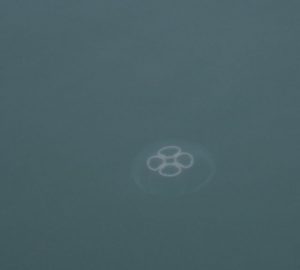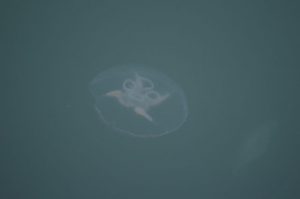On Jellyfish
by Catherine Schmitt
News media and Sea Grant’s coastal correspondents (a.k.a. the Marine Extension Team) have been reporting jellyfish sightings along the coast, from Casco Bay to Penobscot Bay to Frenchman Bay.

I saw them, too—a parade of moon jellies moving up the Damariscotta River. The tide was going out and the jellies were coming in, one after another pulsating toward head of tide.
So many jellyfish! Why are they here? Are they just another symptom of a collapsing ocean, a climate gone crazy?
Maybe. Maybe not.
The large, transparent, slow-moving animals known as jellyfish (“gelatinous zooplankton” to scientists) are found throughout the world’s oceans, from nutrient-rich coastal areas to the Arctic, Antarctic, and tropical seas. Some swim at the surface, some live a few meters down, and some live deeper than that.
Kevin Eckelbarger, a zoologist at UMaine’s Darling Marine Center, studies reproduction of deep-sea jellyfish and other marine invertebrates. As a student of evolution and history, he takes the long view. “Events like these are repeated over and over,” he said, “it’s not unusual—it’s just that maybe it hasn’t happened in your lifetime. The increase in jellyfish this year could be part of a common cycle, or something has changed. We won’t know for some time.” Eckelbarger cautions against attributing the phenomena to any single cause. “It’s much more complicated than that. Everything is interconnected, but we don’t know a lot about many marine organisms.”
Most of the reports this summer have been of the moon jelly (Aurelia aurita), a clear jellyfish with four white or pinkish rings on its top. The moon jelly is related to anemones, corals, and other members of the phylum Cnidaria. The moon jelly does not sting humans, although it does poison the small marine organisms that are its prey (Eckelbarger called jellyfish “marine assassins”). They are eaten by sea turtles and ocean sunfish; sometimes seabirds will peck at them from above. As predators, jellyfish can have a major effect on marine ecosystems. Moon jellies are often seen in large groups, and their presence en masse does not automatically indicate anything abnormal.
Jeff McKeen works for Pemaquid Oyster Company and is on the water every day. He said the jellyfish are around some years and some years they aren’t. “They seem early this year, maybe they are staying longer, usually they are around for about three weeks at a time. But they are not as thick as I’ve seen them in the past.”
Moon jellies do “bloom,” along with other members of their class. The ability to reproduce and grow fast into large concentrations is a byproduct of their evolutionary history, which extends back more than 500 million years. (They are older than humans, and we carry jellyfish genes.) Jellyfish evolved to survive periods of few resources, feeding on whatever was available. Jellyfish are mostly water surrounded by only two layers of cells; they don’t need carbon to build a skeleton so they can concentrate on reproduction. They produce more eggs when food supply is abundant; they stop reproducing, shrink, and hunker down when food is scarce. They can survive in low-oxygen and low-salinity water. And the moon jelly’s complex life cycle includes a polypoid form that lives on the sea floor and can reproduce asexually under certain conditions (like warmer water), producing large numbers of new jellies.
Over the last few decades, jellyfish became a symbol of polluted shorelines, an organism said to proliferate in a damaged ocean. But scientists don’t have extensive long-term monitoring data for jellyfish, as with thousands of other species that we don’t eat or “use.” Recently, tired of the bad rap, some jellyfish biologists pulled together what data do exist to see if they could detect any real trends.
They found that global jellyfish biomass has fluctuated over decadal time frames, with a recent pulse in the 1990s that might partly explain the perception of a global rise in jellyfish. There are apparent localized areas of enhanced blooms of certain jellyfish, however, including the North Atlantic shelf, where biomass is related to sea surface temperature, dissolved oxygen, and phytoplankton production. Only time (and monitoring data) will tell if this summer was the beginning of a jellyfish boom. Certainly, the fauna of the Gulf of Maine is changing. Kevin Eckelbarger noted that the Damariscotta River narrows, which once teemed with marine life like sponges, sea cucumbers, and urchins, are suddenly barren. Meanwhile, non-native tunicates are everywhere. Fish eat the same food as jellyfish, he said, and fewer fish in the ocean could lead to more jellyfish. Or it could be something totally different.
Jellyfish are here this summer. Maybe, for now, we should not care so much about why.
Attributing the appearance of the weird, new, or mysterious to something like climate change—as we are quick to do these days and often rightly so—nevertheless results in a kind of dismissal. We nod and shrug and move on, because we don’t think there’s anything that can be done about such overwhelming change.
But this scenario leaves little time for wonder. Rachel Carson encouraged us to foster our “true instinct for what is beautiful and awe-inspiring,” to let emotions rule, if only for a moment, before we seek out or apply knowledge.

On Kevin Eckelbarger’s desk was a small package, FedExed from New Zealand. Inside were gonads of marine animals collected from a depth of 11,000 meters. Some day soon in the lab, he will slice them very thinly and look at them with an electron microscope, as he has done for decades. But rather than seeing the work as old routine, he finds joy in the chance to see something new. “To study these animals is a unique moment, and a privilege,” he said.
References
Lucas, C.H. et al. 2014. What are jellyfishes and Thaliacians and why do they bloom? pp 9-44 in Jellyfish Blooms (K.A. Pitt and C.H. Lucas, eds.), Springer.
Duarte, C.M., K.A. Pitt, and C.H. Lucas. 2014. Understanding jellyfish blooms, pp. 1-5 in Jellyfish Blooms (K.A. Pitt and C.H. Lucas, eds.), Springer.
Condon, R.H., et al. 2012. Questioning the rise of gelatinous zooplankton in the world’s oceans. BioScience 62:160-169.
Condon, R.H. et al. 2013. Recurrent jellyfish blooms are a consequence of global oscillations. Proceedings of the National Academy of Sciences 110:1000-1005.
Lucas, C.H. et al. 2014. Gelatinous zooplankton biomass in the global oceans: geographic variation and environmental drivers. Global Ecology and Biogeography 23:701-714.
